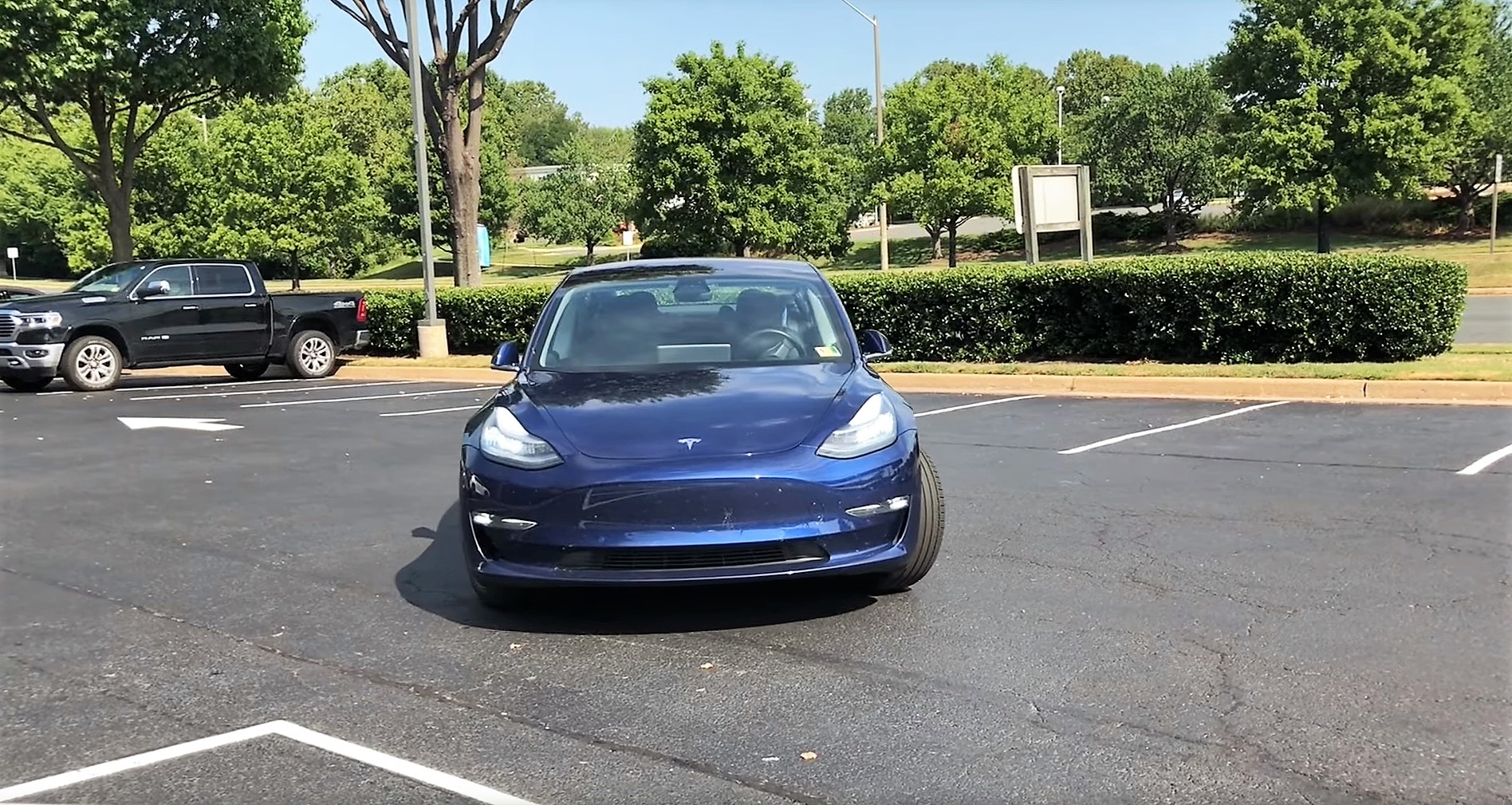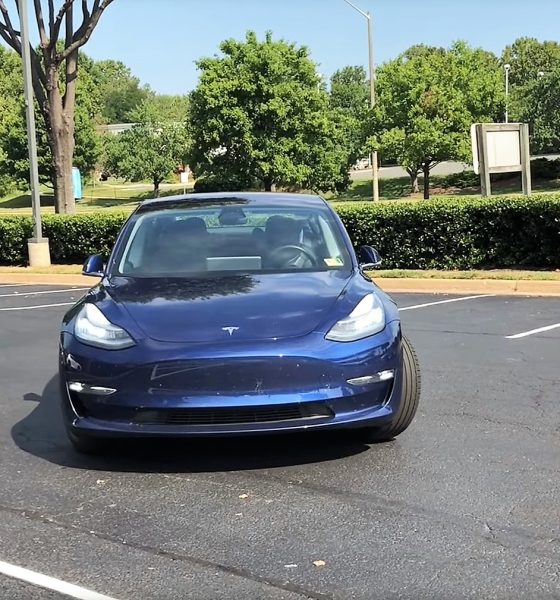

News
First look at Tesla’s ‘more confident’ Smart Summon feature ahead of V10 release
The fourth iteration of Tesla’s Smart Summon feature has begun rolling out to Early Access Program participants, demonstrating the continued development of capabilities that allow drivers to operate their all-electric cars through the Tesla mobile app, specifically by having them autonomously travel to their location. As seen in a recent video demonstrating the program (previously ‘Enhanced Summon’) in action, some notable improvements have been made over the last release, particularly in vehicle confidence and movement execution.
Utilizing the latest version of Smart Summon, a deep blue metallic Model 3 is seen navigating from various parking spaces to selected point locations in a demo posted by YouTube channel, ALL Electric. When exiting each parking spot, the all-electric vehicle seems confident while reversing, and there seems to be an increase in the car’s speed as it executes the Summon command over the prior versions. Another particularly interesting part of the demonstration was the vehicle’s response to the transition from asphalt to brick in its driving path, something which caused the feature to pause and assess the locations of the actual curbs vs. the perceived curbs based on color variations.
Smart Summon’s primary appeal to customers is geared towards parking lot navigation. CEO Elon Musk has ambitious plans for the feature, and has previously stated that a Tesla “should be able to drive around a parking lot, find an empty spot, read signs to confirm it’s valid & park.” However, although a wide release of Smart Summon is coming with Tesla’s upcoming Version 10 firmware update, self-parking looks to still be a ways off yet. This is not surprising given Musk’s previous explanations of the feature’s fine-tuning challenges that are still underway as seen in ALL Electric‘s demo.
- Tesla Model 3 demonstrating latest version of Smart Summon assessing curbs and parking lot composition changes. | Image: ALL Electric/YouTube
- Tesla Model 3 demonstrating latest version of Smart Summon assessing curbs and parking lot composition changes. | Image: ALL Electric/YouTube
“Yeah, we’ve been working on curbs a *lot*. Concrete seams too. So glamorous,” Musk tweeted in response to an update request for the newest Summon at the end of June. When asked what the most difficult part about concrete was, Musk replied, “Excessive shades of grey.” The CEO also jokingly noted that curbs with high contrast were his ‘favorite’. The latest update to Smart Summon demonstrated this particular challenge where the parking lot composition changed, although it was able to determine its drivability after a pause for assessment.
Along with parking lot mobility, Smart Summon already allows Tesla owners with early access to “walk” their cars like a pet by holding down the Summon button on the Tesla app. Musk also promised eventual remote control car capability as well. “Also, you’ll be able to drive it from your phone remotely like a big RC car if in line of sight,” he tweeted in November last year.
Tesla’s V10 firmware, which will also include improvements to Autopilot and WiFi streaming of Netflix and YouTube videos, is estimated to be released later this month. After the company’s Early Access Program results are assessed and addressed, a wide release of the new firmware will follow. “Depends on how release to owners with early access goes, but hopefully wide release by end of August,” Musk replied on Twitter to a question about V10’s availability at the end of last month.
Despite the full promise of the Smart Summon feature yet to be realized, its overall functionality is a remarkable improvement over the current Summon feature which only allows straight-line driving for a maximum of 150 feet.
Watch the latest Enhanced Summon demonstration video below:
https://www.youtube.com/watch?v=ebii6acduRY

News
Tesla starts showing how FSD will change lives in Europe
Local officials tested the system on narrow country roads and were impressed by FSD’s smooth, human-like driving, with some calling the service a game-changer for everyday life in areas that are far from urban centers.

Tesla has launched Europe’s first public shuttle service using Full Self-Driving (Supervised) in the rural Eifelkreis Bitburg-Prüm region of Germany, demonstrating how the technology can restore independence and mobility for people who struggle with limited transport options.
Local officials tested the system on narrow country roads and were impressed by FSD’s smooth, human-like driving, with some calling the service a game-changer for everyday life in areas that are far from urban centers.
Officials see real impact on rural residents
Arzfeld Mayor Johannes Kuhl and District Administrator Andreas Kruppert personally tested the Tesla shuttle service. This allowed them to see just how well FSD navigated winding lanes and rural roads confidently. Kruppert said, “Autonomous driving sounds like science fiction to many, but we simply see here that it works totally well in rural regions too.” Kuhl, for his part, also noted that FSD “feels like a very experienced driver.”
The pilot complements the area’s “Citizen Bus” program, which provides on-demand rides for elderly residents who can no longer drive themselves. Tesla Europe shared a video of a demonstration of the service, highlighting how FSD gives people their freedom back, even in places where public transport is not as prevalent.
What the Ministry for Economic Affairs and Transport says
Rhineland-Palatinate’s Minister Daniela Schmitt supported the project, praising the collaboration that made this “first of its kind in Europe” possible. As per the ministry, the rural rollout for the service shows FSD’s potential beyond major cities, and it delivers tangible benefits like grocery runs, doctor visits, and social connections for isolated residents.
“Reliable and flexible mobility is especially vital in rural areas. With the launch of a shuttle service using self-driving vehicles (FSD supervised) by Tesla in the Eifelkreis Bitburg-Prüm, an innovative pilot project is now getting underway that complements local community bus services. It is the first project of its kind in Europe.
“The result is a real gain for rural mobility: greater accessibility, more flexibility and tangible benefits for everyday life. A strong signal for innovation, cooperation and future-oriented mobility beyond urban centers,” the ministry wrote in a LinkedIn post.
News
Tesla China quietly posts Robotaxi-related job listing
Tesla China is currently seeking a Low Voltage Electrical Engineer to work on circuit board design for the company’s autonomous vehicles.

Tesla has posted a new job listing in Shanghai explicitly tied to its Robotaxi program, fueling speculation that the company is preparing to launch its dedicated autonomous ride-hailing service in China.
As noted in the listing, Tesla China is currently seeking a Low Voltage Electrical Engineer to work on circuit board design for the company’s autonomous vehicles.
Robotaxi-specific role
The listing, which was shared on social media platform X by industry watcher @tslaming, suggested that Tesla China is looking to fill the role urgently. The job listing itself specifically mentions that the person hired for the role will be working on the Low Voltage Hardware team, which would design the circuit boards that would serve as the nervous system of the Robotaxi.
Key tasks for the role, as indicated in the job listing, include collaboration with PCB layout, firmware, mechanical, program management, and validation teams, among other responsibilities. The role is based in Shanghai.
China Robotaxi launch
China represents a massive potential market for robotaxis, with its dense urban centers and supportive policies in select cities. Tesla has limited permission to roll out FSD in the country, though despite this, its vehicles have been hailed as among the best in the market when it comes to autonomous features. So far, at least, it appears that China supports Tesla’s FSD and Robotaxi rollout.
This was hinted at in November, when Tesla brought the Cybercab to the 8th China International Import Expo (CIIE) in Shanghai, marking the first time that the autonomous two-seater was brought to the Asia-Pacific region. The vehicle, despite not having a release date in China, received a significant amount of interest among the event’s attendees.
Elon Musk
Elon Musk and Tesla AI Director share insights after empty driver seat Robotaxi rides
The executives’ unoccupied tests hint at the rapid progress of Tesla’s unsupervised Robotaxi efforts.

Tesla CEO Elon Musk and AI Director Ashok Elluswamy celebrated Christmas Eve by sharing personal experiences with Robotaxi vehicles that had no safety monitor or occupant in the driver’s seat. Musk described the system’s “perfect driving” around Austin, while Elluswamy posted video from the back seat, calling it “an amazing experience.”
The executives’ unoccupied tests hint at the rapid progress of Tesla’s unsupervised Robotaxi efforts.
Elon and Ashok’s firsthand Robotaxi insights
Prior to Musk and the Tesla AI Director’s posts, sightings of unmanned Teslas navigating public roads were widely shared on social media. One such vehicle was spotted in Austin, Texas, which Elon Musk acknowleged by stating that “Testing is underway with no occupants in the car.”
Based on his Christmas Eve post, Musk seemed to have tested an unmanned Tesla himself. “A Tesla with no safety monitor in the car and me sitting in the passenger seat took me all around Austin on Sunday with perfect driving,” Musk wrote in his post.
Elluswamy responded with a 2-minute video showing himself in the rear of an unmanned Tesla. The video featured the vehicle’s empty front seats, as well as its smooth handling through real-world traffic. He captioned his video with the words, “It’s an amazing experience!”
Towards Unsupervised operations
During an xAI Hackathon earlier this month, Elon Musk mentioned that Tesla owed be removing Safety Monitors from its Robotaxis in Austin in just three weeks. “Unsupervised is pretty much solved at this point. So there will be Tesla Robotaxis operating in Austin with no one in them. Not even anyone in the passenger seat in about three weeks,” he said. Musk echoed similar estimates at the 2025 Annual Shareholder Meeting and the Q3 2025 earnings call.
Considering the insights that were posted Musk and Elluswamy, it does appear that Tesla is working hard towards operating its Robotaxis with no safety monitors. This is quite impressive considering that the service was launched just earlier this year.










